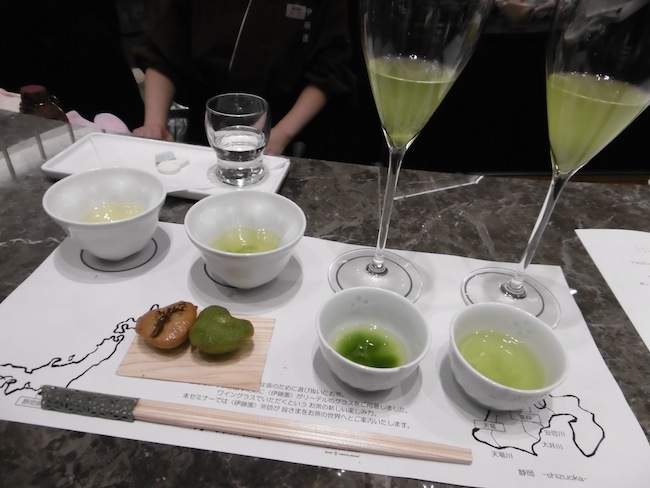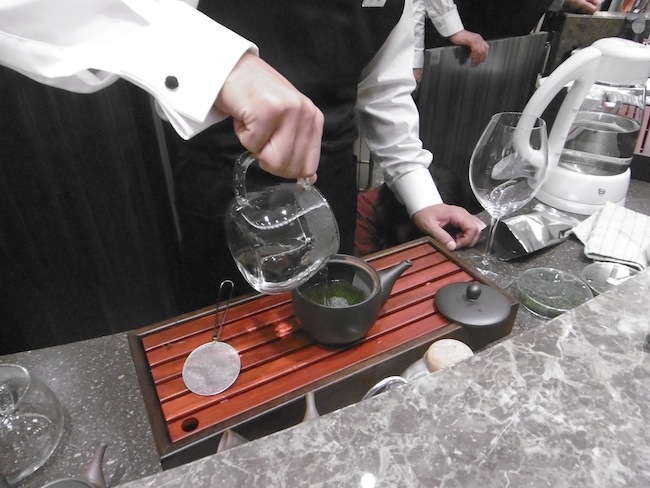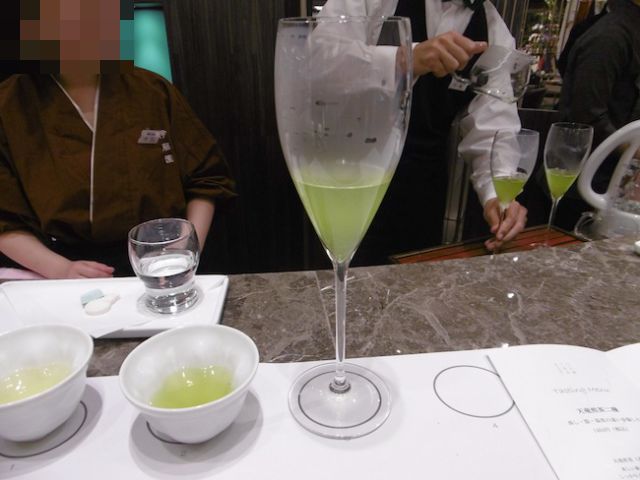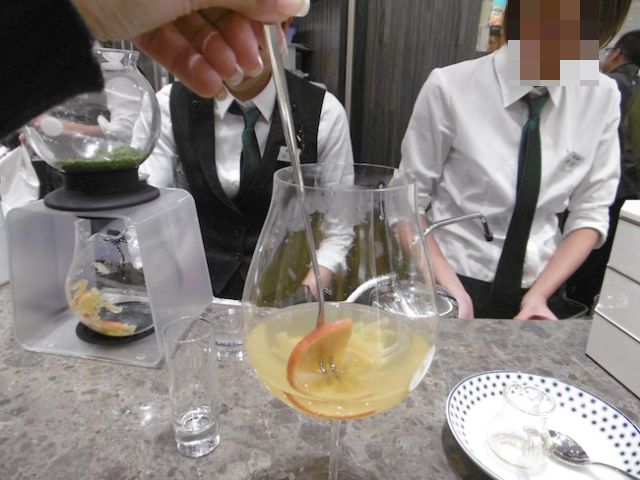
Green tea has always been a popular drink in Japan and is widely consumed here even in plastic bottles. Visitors to Japan are sure to have seen a variety of green tea drinks at convenience stores or vending machines, including those from major tea and beverage maker Ito En.
Now, Ito En and department store Isetan have teamed up to put on a delightful promotional event which they’re calling the “Green Tea Party“, and the event is exactly that – one big tea party, where you can have so many different types of green tea and tea-based beverage creations that you’ll feel like you stepped into a wonderland of Japanese tea. Naturally, we weren’t about to stay away from a good tea party, so we made our way to the branch of Isetan in Tokyo’s Shinjuku neighborhood. Let’s take a look at what we saw and tasted at the event, shall we?
When we reached the store’s fifth floor, where most of the green tea action was going on, we first caught sight of a promotion for a very special gyokuro version of the popular Oi Ocha tea drink from Ito En, which readers may recall we introduced in a previous article.
What’s so special about these beautifully wrapped drinks? Well, they’re made completely from valuable gyokuro green tea leaves, which are carefully grown in the shade for a period of approximately three weeks before picking. The leaves are highly prized for the concentrated flavor they carry as a result of being shielded from the sun in their final stage of growth.
▼ The gyokuro Oi Ocha is beautifully packaged and sells for a cool 1,188 yen (US$9.64) for a 375-milliliter (12.7-ounce) bottle!
And the great part was that they were serving complimentary samples of the special Oi Ocha, and in a wine glass from high-end Austrian wine glass maker Riedel. Even better, the particular wine glass was specifically selected from Ridel’s numerous products after careful tasting to determine which glass was the best match for the gyokuro drink!
They ended up selecting a new world Pinot Noir glass for the gyokuro Oi Ocha, and it tasted excellent, much richer than the usual bottled green tea. And we have to admit, the glass makes it look very elegant as well.
▼ The were also serving green tea infused with various dried fruit, which added a nice zest to the resulting drink.
Next, we made our way to the “Kitchen Dining/Taste of Drink” counter also located on the fifth floor, where they were conducting a unique green tea tasting seminar. You get to taste different teas prepared in different ways by a tea specialist from Ito En and served in different glasses, again including specifically selected Riedel glassware.
▼ The menu included a tasting seminar of a selection of several teas, as well as servings of individual teas grown and processed using different methods. Most were teas grown in Shizuoka, a prefecture located on the southern coast of central Japan and famous for producing excellent green tea.
▼ The setting at the counter included a paper place mat with a map of Japan and of Shizuoka drawn on it.
▼ Here’s the map of Shizuoka Prefecture, with some of the major tea producing areas indicated.
We of course wanted to try the tasting seminar offering the chance to taste a variety of teas served as a set, but before that, we tried some deep steamed (fukamushi) sencha green tea (540 yen [$4.38]) from the Kawane area of Shizuoka.
▼ This is what the tea looked like.
▼ The tea was brewed right in front of us. Japanese green tea is typically prepared at a lower temperature than English tea, usually 70-80 degrees Celsius (158-176 degrees Farenheit) or even as low as 50 degrees Celsius C (122 degrees Farenheit) for gyokuro.
▼ And we have tea in a beautiful green color!
▼ This particular tea was served in a Riedel Shiraz glass, and it was flavorful yet refreshing!
▼ We even received a serving of delicate sugar confections in adorable snowflake and snowman designs.
And now, on to the tasting seminar! We first tried some light roasted (asamushi) sencha from the Tenryu area of Shizuoka Prefecture.
▼ The light steamed tea wasn’t very dark in color, almost golden, but it had a lovely aroma.
▼ Next came the same sencha tea from Tenryu, but deep steamed. The color was darker, and the slightly bitter yet refreshing flavor of green tea was evident.
▼Next came an interesting combination — the same deep steamed tea in a Riedel champagne flute!
▼ Beautifully elegant, and a wonderful way to enjoy the aroma of the tea!
▼ We were also treated to a cold version of the same deep steamed tea from Tenryu, brewed from cold water.
▼ The cold tea, pictured here on the right, was also served in a champagne flute and tasted mellow, even slightly sweet.
Next, we had a kabusecha, a type of tea grown covered under a net for about a week before picking. This kabusecha was produced in the Warashina area of Shizuoka and was stored in a traditional Japanese-style warehouse to mature before brewing. Both the color and flavor were rich and strong.
The last tea we tried was also a kabusecha, grown in the Yame district of Fukuoka Prefecture in the southern island of Kyushu. In addition to having been covered under a net for the last week of their growth, this tea has also been lightly roasted over a charcoal fire, giving it a slightly smoky aroma.
In the end, we tasted six tea drinks and were even served two small financier cakes for a price of 1,404 yen ($11.40), which we have to say really wasn’t a bad deal, especially considering the quality of the tea that was being used!
But the green tea fun didn’t stop there. After the seminar, we made our way to the “Ito En Tea Bar“right next to the tasting counter.
▼ The beverage menu consisted of four creations by tea sommelier Yu Kato, all of them sounding tantalizingly delicious.
▼ We decided to have the “Matcha x Tiramisu” drink (1,404 yen [$11.40]) first. The drink was served in a Riedel champagne flute, with a chestnut paste placed at the bottom, and cold matcha green tea beat to a frothy consistency poured over it.
▼ The green of the matcha with the lighter colored foam resting at the top created a beautiful color pattern.
▼ Small flakes of gold leaf were sprinkled on top.
But that’s not all. This drink came with a special monaka confection. Monaka typically consist of crispy wafer shells filled with bean paste, but the monaka in this case contained a combination of mascarpone cheese and chestnut cream!
▼ Here’s the sphere-shaped monaka…
▼ …presented elegantly on top of the glass.
▼ The bitter flavor of the matcha green tea and the chestnut paste made for a pleasant combination.
The cream-filled monaka was absolutely divine. What’s amazing is that the drink has been carefully designed so that when you have it together with the monaka, it combines to create a taste in your mouth like tiramisu cake!
Next, we had the Hojicha (roasted green tea) Chai Latte with Three Spices (864 yen [$7.01]). Red pepper, cardamon and clove were used to give the latte a spicy zest.
▼ The three spices were ground…
▼ …and brewed in a pot.
▼ Quality wasanbon sugar was then added to another pot…
▼ …which was combined with the brewed spices and roasted tea.
▼ This is the result, served in a Riedel Riesling glass.
▼ Foamed milk was poured on top…
▼ …with a sprinkling of hojicha powder to complete the drink.
▼ With the milk and spices, the drink was mild and relaxing, perfect for winding down before going to bed.
Also on the menu was the Green Tea x Dried Fruits drink (756 yen [$6.14]). First, pieces of dried orange and lemon were placed in a pot, which was then filled with hot water.
Once the water was infused with the flavor and fragrance of the fruit, it was poured into another pot containing green tea.
▼ Some of the fruit was placed in a new world Pinot Noir glass.
▼ The hot water in the pot of green tea was extracted into the first pot containing the fruit.
▼ And we had the finished drink!
▼ The light orange color form the fruit was beautiful!
▼ We also got a serving of lavender honey which we could added halfway through our drink.
This drink was a pleasant surprise, as the aroma smelled strongly of citrus, and when tasted, there was a definite fruit flavor. However, the refreshing light taste of green tea was clearly there as well.
Lastly, we had the Genmaicha (brown rice tea) with a Pink Plum Espuma drink (1,080 yen [$8.77]). Now, just the name of the drink alone sounds fascinating!
First they brewed a pot of brown rice tea. It was surprising to see how bright green the tea was.
Next, a blend of plum paste and gelatin was whipped into an espuma.
▼ The brown rice tea was cooled in a pot of ice…
▼ …then poured into a Riedel coupe glass.
▼ The espuma was poured over the tea.
▼ Cute little rice crackers were sprinkled on top of the pale pink foam, creating a stunning visual effect.
▼ And there you have the finished drink!
This drink was served with a stylish monaka filled with traditional red bean paste and pieces of dried yuzu citrus on top. Yum!
▼ The flavor of the plum in the espuma added a delightful bit of tang to the light fresh taste of the brown rice tea.
So, that brings us to the end of our report on the Green Tea Party at Shinjuku Isetan. We certainly had a wonderful time trying all these different teas, and we’re sure anyone who has even a remote interest in tea would find it a fascinating experience.
The event itself will be going on until November 10, and while the gyokuro Oi Ocha service is held only on select days, the tasting seminar is held four to five times daily, and the Ito En Tea Bar is open throughout the day. If you do have the chance to be in the area, it’s definitley worth visiting the department store for the various teas and the creative drinks — it really is a veritable green tea feast!
Photos ©RocketNews24







































































 Japan’s finest green tea, now available in bottled form at an eye-popping price
Japan’s finest green tea, now available in bottled form at an eye-popping price Japan’s Oi Ocha green tea keeps going upscale with new bottled matcha costing 1,000 yen a bottle
Japan’s Oi Ocha green tea keeps going upscale with new bottled matcha costing 1,000 yen a bottle Alcoholic tea ceremony? We try Suntory’s new matcha green tea liquor 【Taste test】
Alcoholic tea ceremony? We try Suntory’s new matcha green tea liquor 【Taste test】 We enter a mixed martial arts tournament held by tea maker Ito En
We enter a mixed martial arts tournament held by tea maker Ito En Japanese green tea vending machine has a puppet show that tells the story behind the drink
Japanese green tea vending machine has a puppet show that tells the story behind the drink We revisited Sweets Paradise after a decade to see if Japan’s dessert buffet still delivers
We revisited Sweets Paradise after a decade to see if Japan’s dessert buffet still delivers Japanese group to hold fashion show of colostomy bags and other stoma equipment in Paris
Japanese group to hold fashion show of colostomy bags and other stoma equipment in Paris Starbucks Japan ready to get Year of the Horse started with adorable drinkware and plushies【Pics】
Starbucks Japan ready to get Year of the Horse started with adorable drinkware and plushies【Pics】 Miss World Japan: The great-times-20-granddaughter of samurai lord One-Eyed Dragon
Miss World Japan: The great-times-20-granddaughter of samurai lord One-Eyed Dragon Japanese thug wear from Birth Japan perfect for those breaking bad next year
Japanese thug wear from Birth Japan perfect for those breaking bad next year Brand-new Pokémon park opens in Japan with larger-than-life-size Lapras【Photos】
Brand-new Pokémon park opens in Japan with larger-than-life-size Lapras【Photos】 Uniqlo Ukiyo-e Blue T-shirts: A cool-hued reinterpretation of some of Japan’s greatest paintings
Uniqlo Ukiyo-e Blue T-shirts: A cool-hued reinterpretation of some of Japan’s greatest paintings Brand-new Pokémon manhole covers coming to Japan’s snowy Hokkaido Prefecture!
Brand-new Pokémon manhole covers coming to Japan’s snowy Hokkaido Prefecture! Hello Kitty Choco Egg figures are an adorable trip through three periods of Japanese pop culture【Pics】
Hello Kitty Choco Egg figures are an adorable trip through three periods of Japanese pop culture【Pics】 Meet Issie, Japan’s very own Loch Ness Monster
Meet Issie, Japan’s very own Loch Ness Monster 7-Eleven Japan’s ramen-cooking robot whipped us up a bowl of noodles【Taste test】
7-Eleven Japan’s ramen-cooking robot whipped us up a bowl of noodles【Taste test】 Cyberpunk anime meets traditional culture in Ghost in the Shell gold leaf Japanese changing screens
Cyberpunk anime meets traditional culture in Ghost in the Shell gold leaf Japanese changing screens 7 great places to see Mt. Fuji from without having to climb it
7 great places to see Mt. Fuji from without having to climb it Japan’s otoshidama tradition of giving kids money at New Year’s gets a social welfare upgrade
Japan’s otoshidama tradition of giving kids money at New Year’s gets a social welfare upgrade We found possibly the quietest Japanese-style hotel in Tokyo’s bustling Shinjuku district
We found possibly the quietest Japanese-style hotel in Tokyo’s bustling Shinjuku district Lacquerware supplier to emperor of Japan and Pokémon team up for new tableware
Lacquerware supplier to emperor of Japan and Pokémon team up for new tableware Sumo Sanrio! Hello Kitty and pals team up with Japan Sumo Association for new merch【Pics】
Sumo Sanrio! Hello Kitty and pals team up with Japan Sumo Association for new merch【Pics】 Can a dirty butthole make you filthy rich in Japan? We’re starting a New Year’s lottery experiment
Can a dirty butthole make you filthy rich in Japan? We’re starting a New Year’s lottery experiment 7-Eleven Japan starts new temporary luggage storage service in over 300 branches
7-Eleven Japan starts new temporary luggage storage service in over 300 branches Disillusionment at Tsukiji’s tourist-target prices led us to a great ramen restaurant in Tokyo
Disillusionment at Tsukiji’s tourist-target prices led us to a great ramen restaurant in Tokyo Starbucks teams up with 166-year-old Kyoto doll maker for Year of the Horse decorations【Photos】
Starbucks teams up with 166-year-old Kyoto doll maker for Year of the Horse decorations【Photos】 Tokyo considering law requiring more trash cans following litter increase in heavily touristed area
Tokyo considering law requiring more trash cans following litter increase in heavily touristed area Tokyo’s Tsukiji sushi neighborhood asks tour groups to stay away for the rest of the month
Tokyo’s Tsukiji sushi neighborhood asks tour groups to stay away for the rest of the month Nintendo’s Kirby now delivering orders at Kura Sushi restaurants, but not in Japan
Nintendo’s Kirby now delivering orders at Kura Sushi restaurants, but not in Japan Tokyo event lets you travel back in time, for free, to celebrate 100 years since Showa era start
Tokyo event lets you travel back in time, for free, to celebrate 100 years since Showa era start Sanrio theme park in Japan announces plans to expand into a Sanrio resort
Sanrio theme park in Japan announces plans to expand into a Sanrio resort Japan may add Japanese language proficiency, lifestyle classes to permanent foreign resident requirements
Japan may add Japanese language proficiency, lifestyle classes to permanent foreign resident requirements Survey asks foreign tourists what bothered them in Japan, more than half gave same answer
Survey asks foreign tourists what bothered them in Japan, more than half gave same answer Japan’s human washing machines will go on sale to general public, demos to be held in Tokyo
Japan’s human washing machines will go on sale to general public, demos to be held in Tokyo Japan’s deadliest food claims more victims, but why do people keep eating it for New Year’s?
Japan’s deadliest food claims more victims, but why do people keep eating it for New Year’s? We deeply regret going into this tunnel on our walk in the mountains of Japan
We deeply regret going into this tunnel on our walk in the mountains of Japan Studio Ghibli releases Kodama forest spirits from Princess Mononoke to light up your home
Studio Ghibli releases Kodama forest spirits from Princess Mononoke to light up your home Major Japanese hotel chain says reservations via overseas booking sites may not be valid
Major Japanese hotel chain says reservations via overseas booking sites may not be valid Put sesame oil in your coffee? Japanese maker says it’s the best way to start your day【Taste test】
Put sesame oil in your coffee? Japanese maker says it’s the best way to start your day【Taste test】 No more using real katana for tourism activities, Japan’s National Police Agency says
No more using real katana for tourism activities, Japan’s National Police Agency says Starbucks Japan reveals new sakura drinkware collection, inspired by evening cherry blossoms
Starbucks Japan reveals new sakura drinkware collection, inspired by evening cherry blossoms Updated cherry blossom forecast shows extra-long sakura season for Japan this year
Updated cherry blossom forecast shows extra-long sakura season for Japan this year Why does Häagen-Dazs Japan have two different types of green tea ice cream, and do we need both?
Why does Häagen-Dazs Japan have two different types of green tea ice cream, and do we need both? Häagen-Dazs Japan’s Yuzu Green Tea Float — How to make the super-easy matcha summer dessert drink
Häagen-Dazs Japan’s Yuzu Green Tea Float — How to make the super-easy matcha summer dessert drink Green tea continues to go alcoholic with new matcha liqueur from Suntory
Green tea continues to go alcoholic with new matcha liqueur from Suntory New illy matcha coffee drinks combine green tea with espresso for a limited time
New illy matcha coffee drinks combine green tea with espresso for a limited time Godiva Japan’s amazing new matcha dessert drink looks like a gift from the green tea gods
Godiva Japan’s amazing new matcha dessert drink looks like a gift from the green tea gods Twist-cap matcha is the freshest bottle of tea you’ll ever get at a Japanese convenience store
Twist-cap matcha is the freshest bottle of tea you’ll ever get at a Japanese convenience store Make luxurious, stylish green tea at home with this matcha warabi latte kit
Make luxurious, stylish green tea at home with this matcha warabi latte kit Japanese company develops matcha paste that retains more health benefits than a cup of green tea
Japanese company develops matcha paste that retains more health benefits than a cup of green tea Starbucks Japan brings out Shaken Apple Green Tea for a limited time
Starbucks Japan brings out Shaken Apple Green Tea for a limited time Ultra-premium matcha, koji rice mold star in Starbucks Japanese New Year’s Frappuccino and drinks
Ultra-premium matcha, koji rice mold star in Starbucks Japanese New Year’s Frappuccino and drinks Japanese tea commercial actress created by AI, has some wondering if it’s the scandal-free future
Japanese tea commercial actress created by AI, has some wondering if it’s the scandal-free future Starbucks promises “new world of matcha” with green tea cheese Frappuccino, citrus green tea
Starbucks promises “new world of matcha” with green tea cheese Frappuccino, citrus green tea Nestlé Japan releases new green tea Kit Kats as part of their “I LOVE TEA” series
Nestlé Japan releases new green tea Kit Kats as part of their “I LOVE TEA” series Green tea ramen? Of course we had to give it a try!【Taste Test】
Green tea ramen? Of course we had to give it a try!【Taste Test】 Ito En releases drinkable cold ramen in Japan
Ito En releases drinkable cold ramen in Japan
Leave a Reply